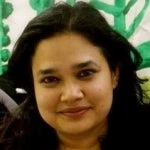 東日本大震災後の復興過程において、地域コミュニティの拠点で料理をする地元の女性たち(写真:Emi Kiyota)
東日本大震災後の復興過程において、地域コミュニティの拠点で料理をする地元の女性たち(写真:Emi Kiyota)
What can make communities more resilient?
Cooking says Takako Kotake, vice president at Cookpad Inc, a Tokyo-based online recipe-sharing platform that boasts more than 100 million users worldwide.
On September 1, on Disaster Prevention Day which commemorates Japan’s Great Kanto Earthquake of 1923, Cookpad issued a special recipe book.
The book contains ideas to prepare meals with limited tools and alternative ingredients. Platform users who had to feed during a disaster—with limited water or energy—contributed their cooking tips.
If this basic form of cooking can help communities survive a disaster, what are the policy recipes that can sustain the overall resilience of communities?
Recipes for resilience in Sri Lanka
While disasters such as earthquakes or floods affect everyone, their impacts are unevenly felt by different population groups.
The project will pioneer three recipes for #ResilienceforAll:
First, its early warning system can deliver disaster alerts customized for differently-abled people.
Second, a citizen monitoring committee is set up to involve communities in the design, construction and maintenance of flood infrastructure to mitigate the impact of water intrusions. The committee represent different groups and help convey feedback to the government.
Third, vulnerable communities will have the opportunity to relocate to safer locations and receive assistance, like priority resettlement for some families, livelihood support,and the option for female and male joint ownership of land and assets.
How does the World Bank support resilience for all in South Asia?
The World Bank and the Global Facility for Disaster Reduction and Recovery (GFDRR) are working to develop a recipe to advance resilience for South Asia and beyond.
For example, as part of its plan to provide safe havens to nearly 14 million people in nine coastal districts, Bangladesh is making emergency evacuation shelters more accessible to differently-abled people.
Some options may include text messages that flicker a light for the hearing-impaired and warning sounds and text-to-voice for people who can’t read or are visually impaired.
It also includes dedicated rooms with attached toilets for the elderly, pregnant women, people with disabilities, and illustrative signage to communicate with those with limited literacy and small children.
In Nepal, as part of the post-disaster reconstruction following the 2015 earthquake, people with different abilities are encouraged to develop new skills to enhance their entrepreneurship.
Recently, a pilot training was conducted to foster trainers who can help differently-abled people identify appropriate entrepreneurship opportunities depending on their ability and help them establish small businesses.
During the two-week program, differently-abled people and trainers explored various business ideas to establish custom-made business opportunities for each.
We will discuss this approach to resilience in Tokyo on November 20, with the University of California at Davis, Japan Women’s Network for Disaster Risk Reduction, and Japan International Corporation Agency.



Join the Conversation